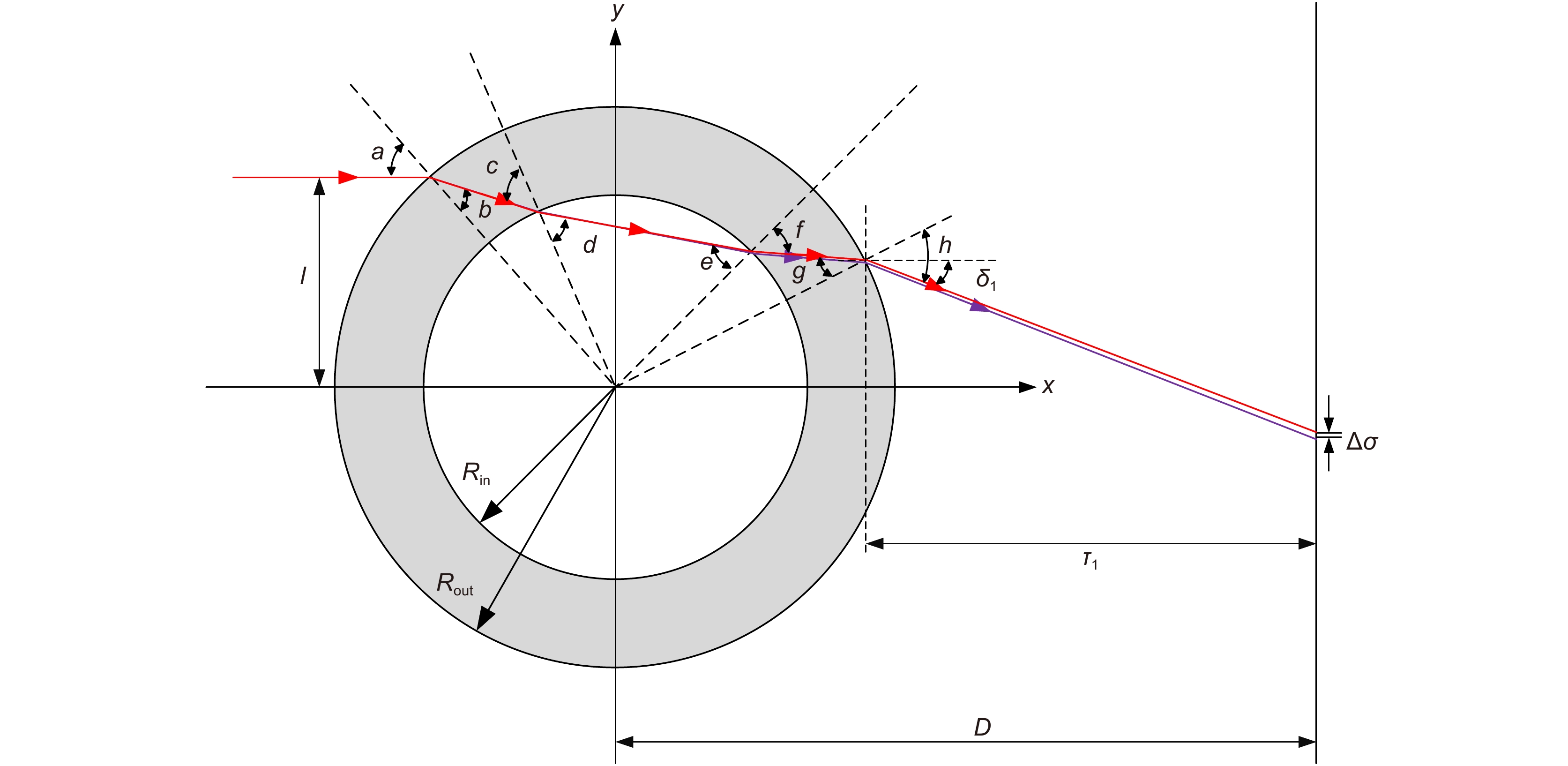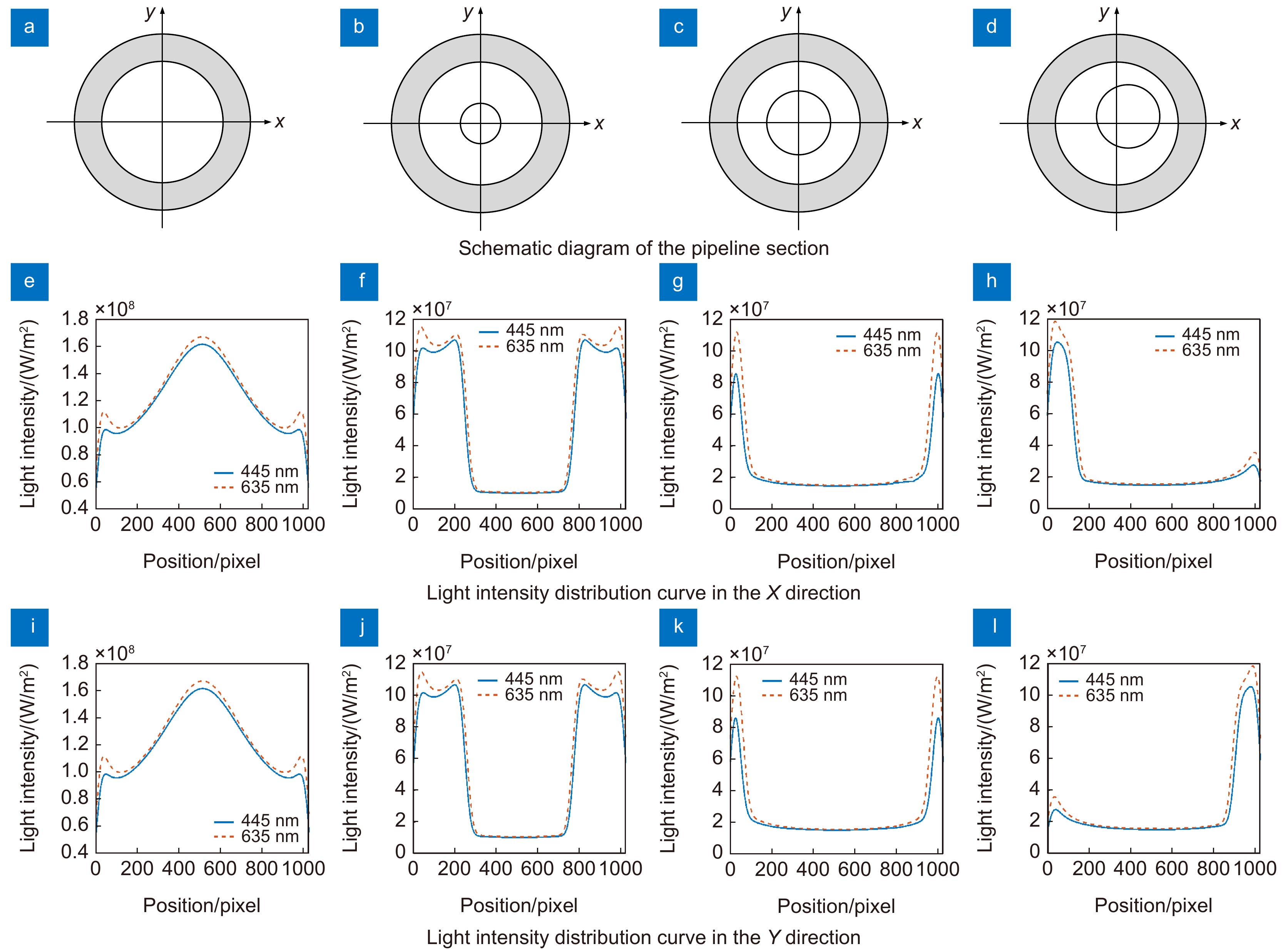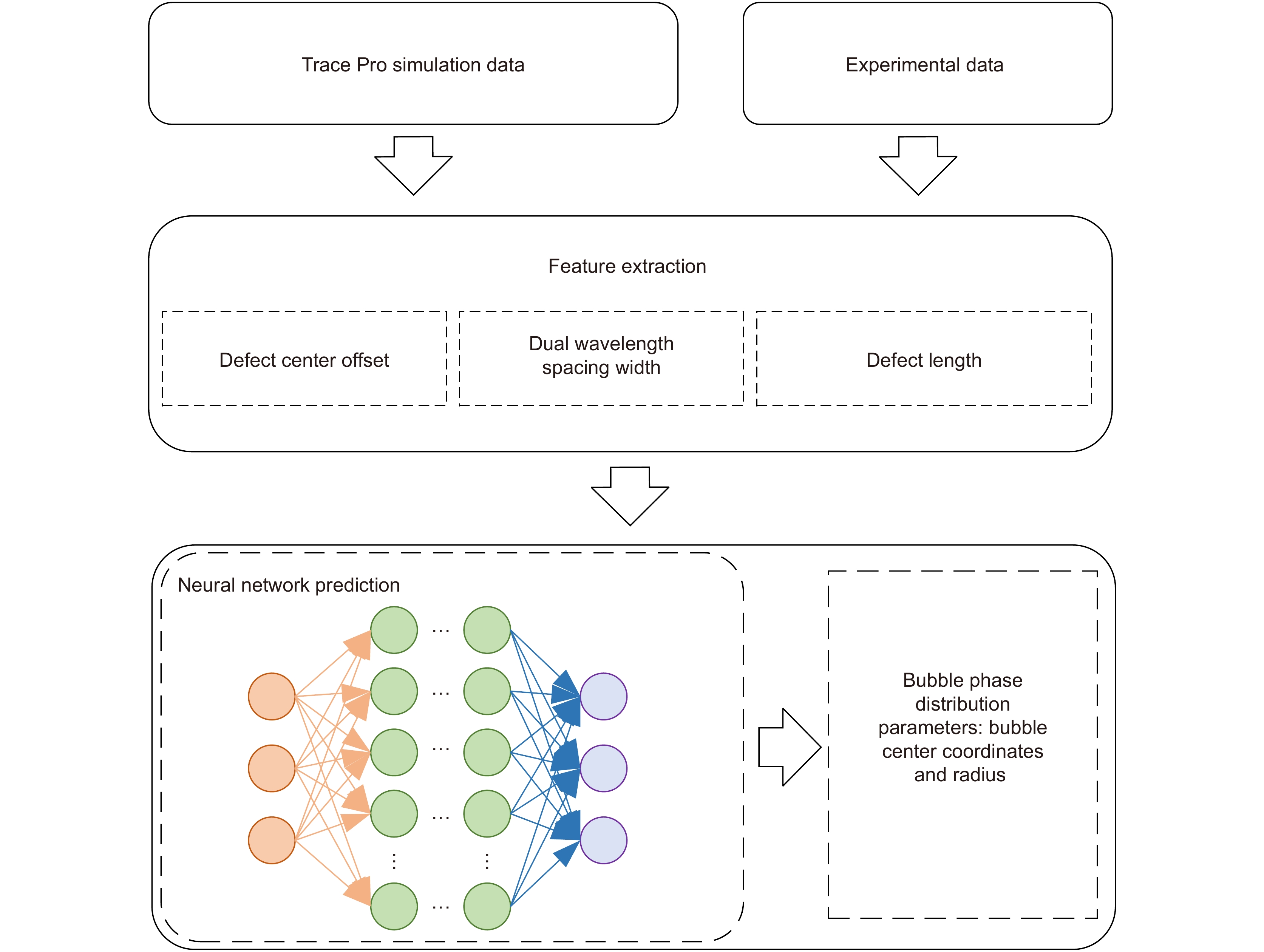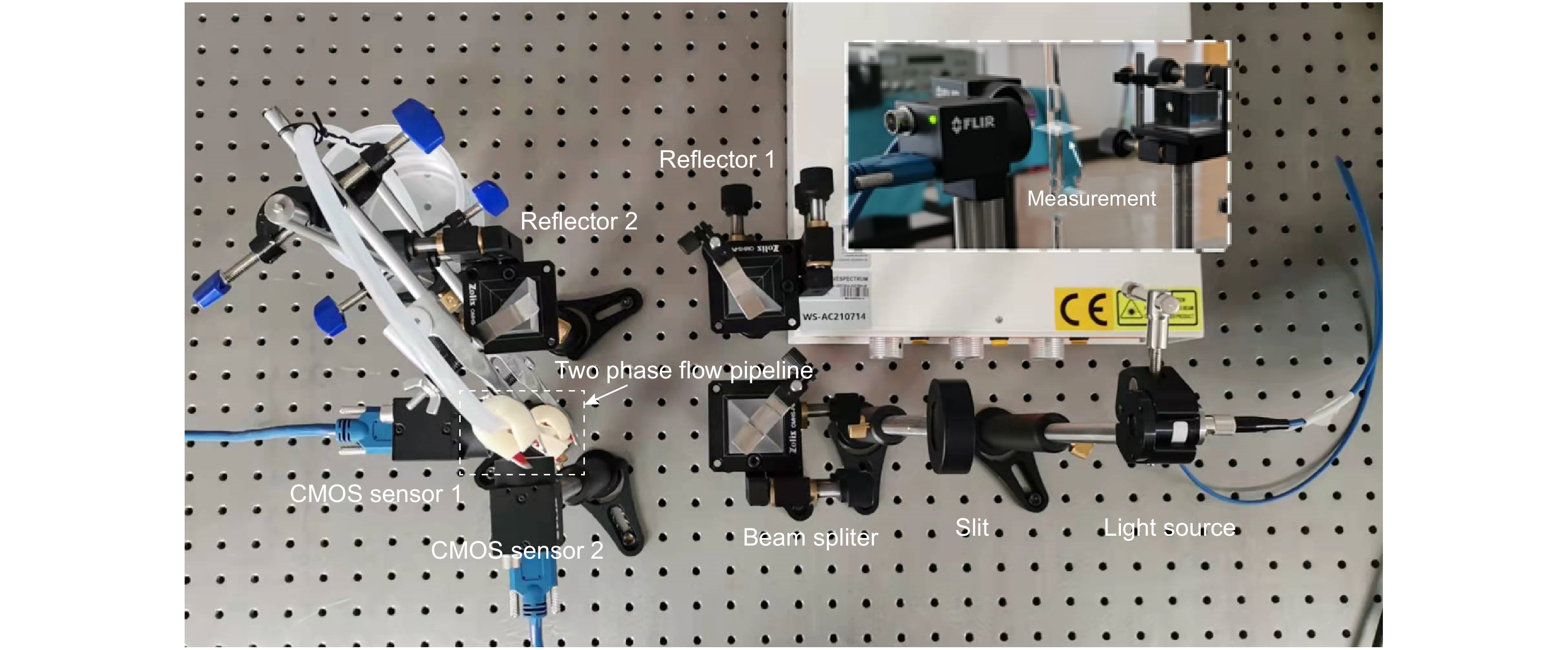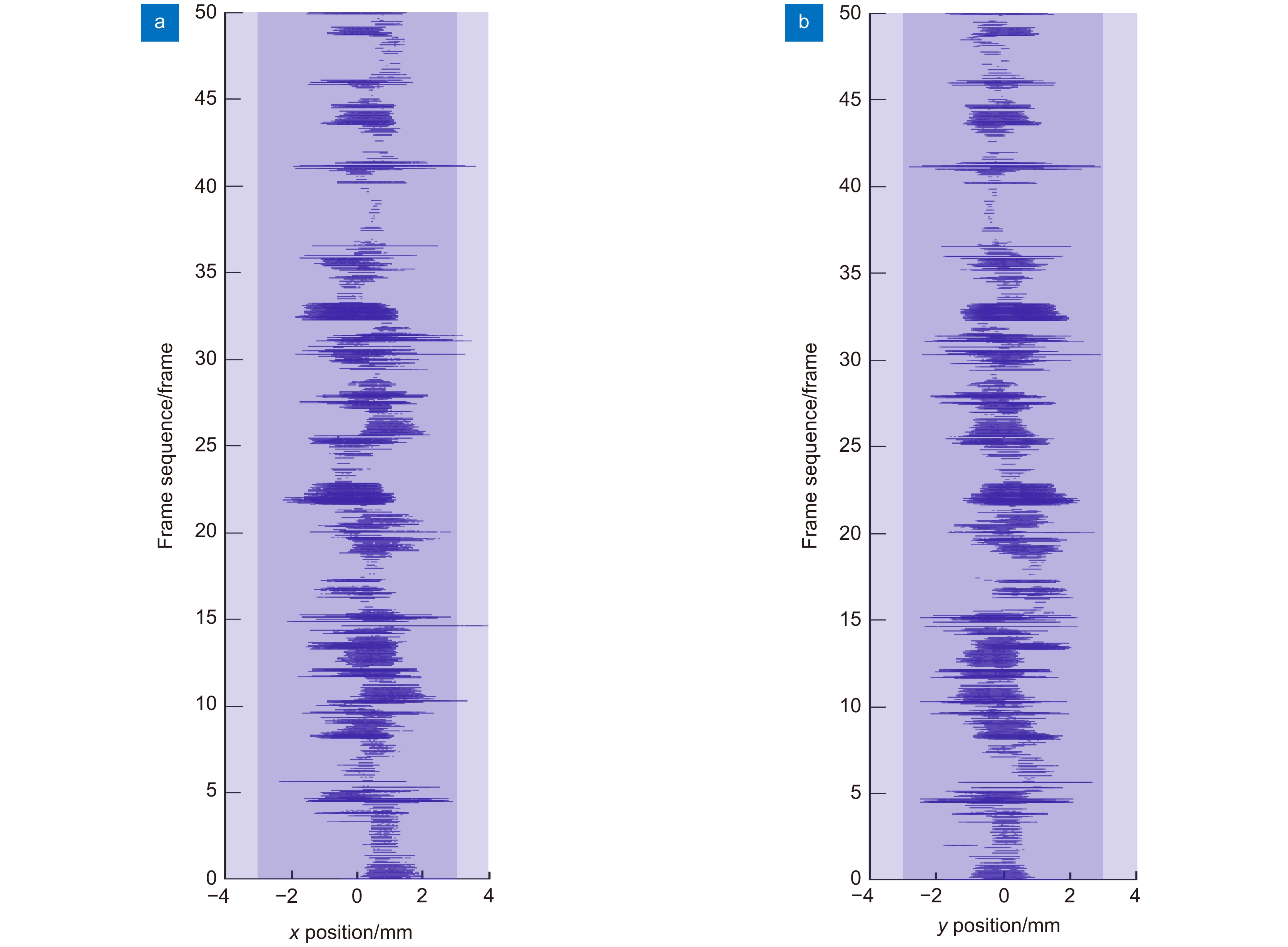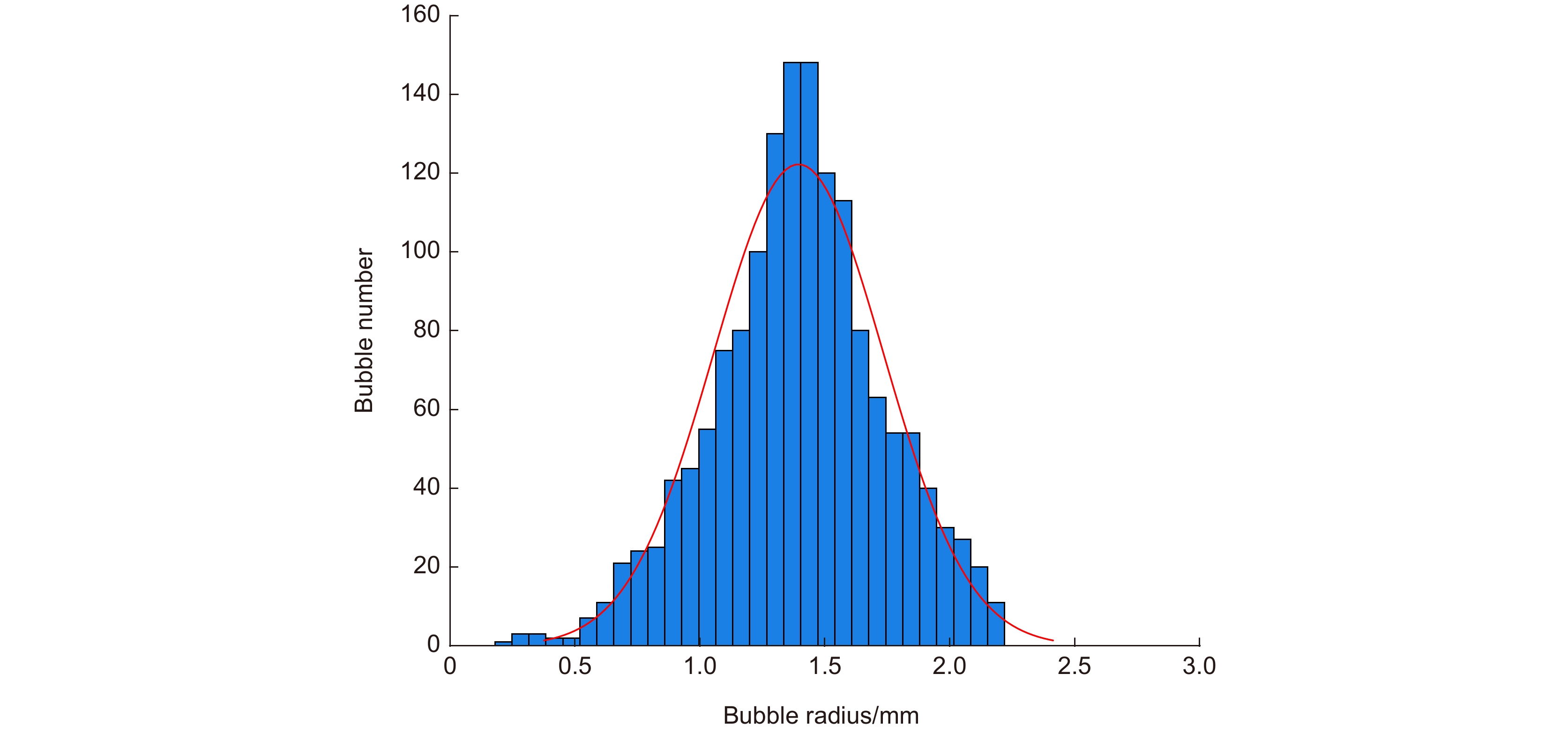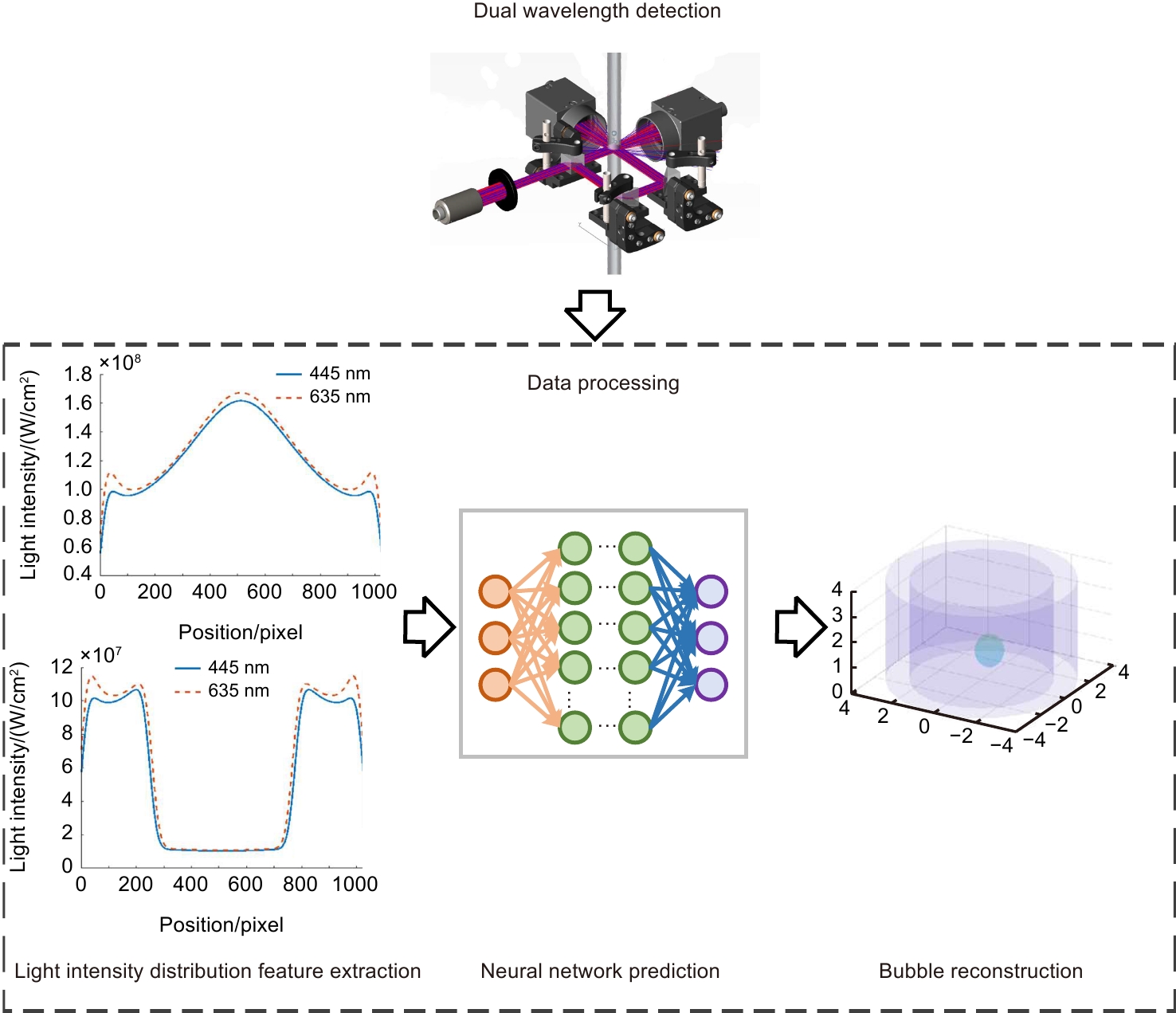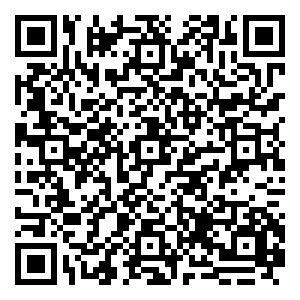-
摘要
针对已有单波长方法测量小通道竖直上升气液两相气泡流相分布参数误差较大的问题,提出了用双波长透射法进行测量研究。通过几何光学原理计算双波长激光经过气液两相流的光强分布,然后提取双波长光强分布特征量,建立了一种基于双波长测量理论的气泡流相分布参数识别模型。利用Trace Pro模拟445 nm、635 nm的激光经过位于管道截面不同位置处的不同尺寸气泡时,得到相应光强分布曲线并提取出特征量,使用仿真得到的特征量数据集对神经网络进行训练,将训练好的神经网络用来预测实验中气泡流的相分布。仿真实验结果表明,建立的模型对气泡中心位置、半径预测的平均绝对误差分别为0.018 mm、0.007 mm,均优于单波长方法,证明了所建模型的有效性和准确性。在搭建的实验平台进行了气泡流测量,重建了气泡流的三维图。
Abstract
Aiming at the deficiency of the existing single-wavelength method in measuring the phase distribution parameters of the vertically rising gas-liquid two-phase bubble flow in a small channel, a dual-wavelength method is proposed. Based on the principle of geometric optics, the light intensity distribution of dual-wavelength laser passing through gas-liquid-two-phase-flow is calculated, and the characteristics of light intensity distribution of dual-wavelength laser are extracted. An identification model of bubble flow phase distribution parameters based on the dual-wavelength measurement theory is established. Trace Pro is used to simulate 445 nm and 635 nm laser passing through bubbles with different phase distribution parameters, and then the features of the dual-wavelength light intensity distribution curves can be extracted. The characteristic quantity data set of simulation is used to train the neural network. The trained neural network is used to predict the phase distribution parameters of bubble flow in the experiment. The simulation results show that the average absolute errors of the model for predicting the bubble center position and radius are 0.018 mm and 0.007 mm respectively, which are better than the single-wavelength method, which proves the effectiveness and accuracy of the model. The bubble flow was measured on the experimental platform, and the three-dimensional diagram of bubble flow was reconstructed.
-
Key words:
- geometric optics /
- dual-wavelength /
- two-phase flow /
- small channel /
- bubble flow /
- neural network
-
Overview
Overview: Gas-liquid two-phase flow is widely used in the industrial field, and one of the typical flow patterns is bubble flow. Therefore, measuring the bubble flow phase distribution parameters is of great significance for studying the characteristics of two-phase flow and industrial production. Optical technology is widely used in small-channel gas-liquid two-phase flow detection, and it can be divided into invasive and non-invasive. Invasive optical detection methods will affect the characteristics of gas-liquid two-phase flow to a certain extent, so non-invasive measurement is an important research direction of optical technology. Some scholars have proposed a method of measuring phase distribution based on the characteristics of single-wavelength light intensity distribution, but the established model is only suitable for the horizontal pipeline, and the resulting error is large. To solve this problem, a dual-wavelength measurement model of bubble flow phase distribution parameters is proposed in this paper, to obtain more optical signal characteristics of laser passing through bubble flow in small channels and reduce the measurement error of phase distribution parameters. The phase distribution and parameter distribution of vertically rising gas-liquid two-phase bubble flow in a small channel are measured and studied by the dual-wavelength transmission method. The light intensity distribution of dual-wavelength laser passing through gas-liquid two-phase flow is calculated based on the principle of the geometric optics, and then the characteristic quantity of dual-wavelength light intensity distribution is extracted. An identification model of bubble flow phase distribution parameters based on the dual-wavelength measurement theory is established. Trace Pro is used to trace the refraction trajectories of 445 nm and 635 nm laser passing through the pipe section containing bubbles with different phase distribution parameters, and the corresponding light intensity distribution curves are obtained. The key features of the corresponding double wavelength light intensity distribution curves are studied, and three kinds of characteristic parameters are extracted: missing part length, missing part offset, and double wavelength interval length. The neural network is trained by using the simulated feature data set, and the trained neural network is used to predict the phase distribution parameters of bubble flow in the experiment. The simulation results show that the prediction results are in good agreement with the simulation data, and the relative error is within ± 5%. The average absolute errors of the established model for the prediction of bubble center position and radius are 0.018 mm and 0.007 mm respectively. The results show that the dual-wavelength method has higher accuracy and is more suitable for the measurement of gas-liquid two-phase flow. Finally, a dual-wavelength gas-liquid two-phase flow measurement system is built. The bubble flow in the small vertical rising channel with the small gas flow is measured by using a dual-wavelength laser light source. The bubble flow is obtained by injecting gas into the stagnant liquid column. The experimental research is carried out, and the bubble sizes distribution curve is counted. In general, the dual-wavelength measurement method provides good results and is an alternative method for the measurement of bubble phase distribution parameters. This technology is helpful to measure and monitor bubble flow parameters online.
-

-
表 1 单波长和双波长预测结果准确率对比
Table 1. Comparison of accuracy of single-wavelength and dual-wavelength prediction results
Single wavelength Dual-wavelength Mean absolute error ε/mm Mean square error σ/mm Probability within ± 5% error γ5/% Mean absolute error ε/mm Mean square error σ/mm Probability within ± 5% error γ5 /% Bubble center x coordinate 0.0287 0.0017 0.7556 0.0186 0.0011 0.8895 Bubble center y coordinate 0.0276 0.0019 0.7950 0.0179 0.0009 0.8611 Bubble size r 0.0100 0.0004 0.8425 0.0071 0.0003 0.8989 -
参考文献
[1] Roshani M, Phan G T T, Ali P J M, et al. Evaluation of flow pattern recognition and void fraction measurement in two-phase flow independent of oil pipeline’s scale layer thickness[J]. Alex Eng J, 2021, 60(1): 1955−1966. doi: 10.1016/j.aej.2020.11.043
[2] Ciriminna R, Pagliaro M, Luque R. Heterogeneous catalysis under flow for the 21st century fine chemical industry[J]. Green Energy Environ, 2021, 6(2): 161−166. doi: 10.1016/j.gee.2020.09.013
[3] Mir S, Akbari O A, Toghraie D, et al. A comprehensive study of two-phase flow and heat transfer of water/Ag nanofluid in an elliptical curved minichannel[J]. Chin J Chem Eng, 2020, 28(2): 383−402. doi: 10.1016/j.cjche.2019.07.007
[4] 薛婷, 阮维鹏, 张少杰. 基于激光扫描的密集泡状流三维重建与优化[J]. 光学精密工程, 2017, 25(3): 555−561. doi: 10.3788/OPE.20172503.0555
Xue T, Ruan W P, Zhang S J. 3D reconstruction and optimization of dense bubbly flow based on laser scanning[J]. Opt Precis Eng, 2017, 25(3): 555−561. doi: 10.3788/OPE.20172503.0555
[5] Hohermuth B, Kramer M, Felder S, et al. Velocity bias in intrusive gas-liquid flow measurements[J]. Nat Commun, 2021, 12(1): 4123. doi: 10.1038/s41467-021-24231-4
[6] Ma Y, Muilwijk C, Yan Y J, et al. Measurement of bubble flow frequency in chemical processes using an optical fiber sensor[C]//2018 IEEE SENSORS, 2018: 1–4.
[7] Onofri F. Critical angle refractometry for simultaneous measurement of particles in flow: size and relative refractive index[J]. Part Part Syst Charact, 1999, 16(3): 119−127. doi: 10.1002/(SICI)1521-4117(199908)16:3<119::AID-PPSC119>3.0.CO;2-1
[8] Jagannathan N, Chidambaram B, Seshadri A, et al. Characterization of gas-liquid two-phase flows using laser patterns[J]. Can J Chem Eng, 2015, 93(9): 1678−1685. doi: 10.1002/cjce.22242
[9] Arunaganesan S, Adhavan J, Arunkumar S, et al. Laser-based measurement of gas–liquid two-phase flows in micro and mini channels using multiple photodiode arrangement[J]. Chem Eng Commun, 2017, 204(3): 337−347. doi: 10.1080/00986445.2016.1270942
[10] Vendruscolo T P, Fischer R, Martelli C, et al. Two-phase flow measurement based on oblique laser scattering[J]. Proc SPIE, 2015, 9655: 965541.
[11] Revellin R, Dupont V, Ursenbacher T, et al. Characterization of diabatic two-phase flows in microchannels: flow parameter results for R-134a in a 0.5 mm channel[J]. Int J Multiphase Flow, 2006, 32(7): 755−774. doi: 10.1016/j.ijmultiphaseflow.2006.02.016
[12] Long J, Ji H F, Wang B L, et al. Online parameters measurement of Taylor flow in small channels using optical technique[C]//2012 IEEE International Instrumentation and Measurement Technology Conference Proceedings, 2012: 2322–2325.
[13] Duan R X, Yu D, Wu H H, et al. Optical method for flow patterns discrimination, slug and pig detection in horizontal gas liquid pipe[J]. Flow Meas Instrum, 2013, 32: 96−102. doi: 10.1016/j.flowmeasinst.2013.03.001
[14] Mithran N, Muniyandi V. IR transceiver irradiation characteristics on bubble/slug flow regimes in conventional and minichannels[J]. IEEE Trans Instrum Meas, 2019, 68(1): 240−249. doi: 10.1109/TIM.2018.2843078
[15] 戴振韬. 小通道泡状流和段塞流相分布光学检测研究[D]. 杭州: 浙江大学, 2020.
Dai Z T. Study on optical measurement of phase distribution for bubble flow and slug flow in small channels[D]. Hangzhou: Zhejiang University, 2020.
[16] Schleicher E, Da Silva M J, Thiele S, et al. Design of an optical tomograph for the investigation of single-and two-phase pipe flows[J]. Meas Sci Technol, 2008, 19(9): 094006. doi: 10.1088/0957-0233/19/9/094006
-
访问统计


 E-mail Alert
E-mail Alert RSS
RSS
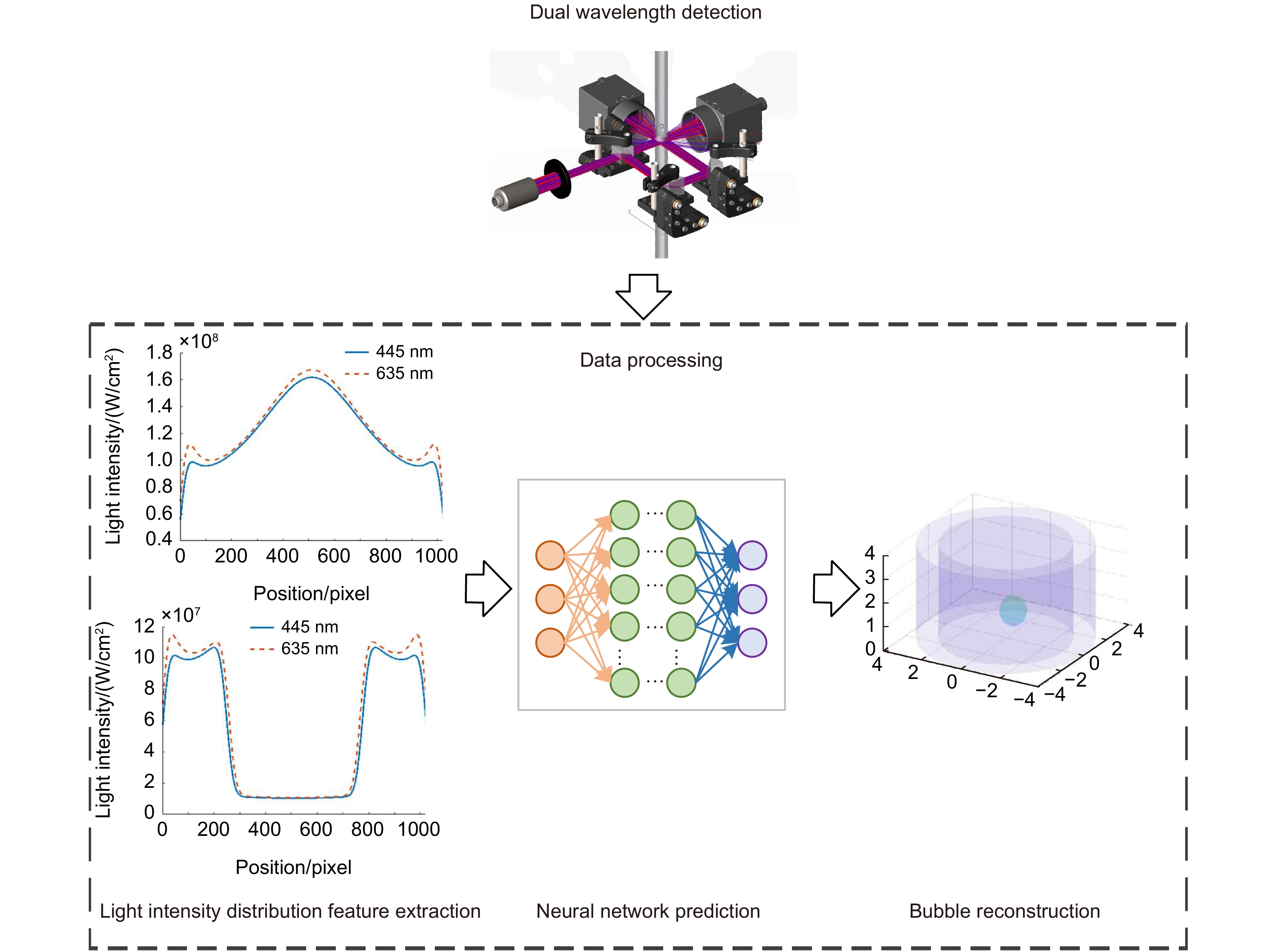
 下载:
下载:
